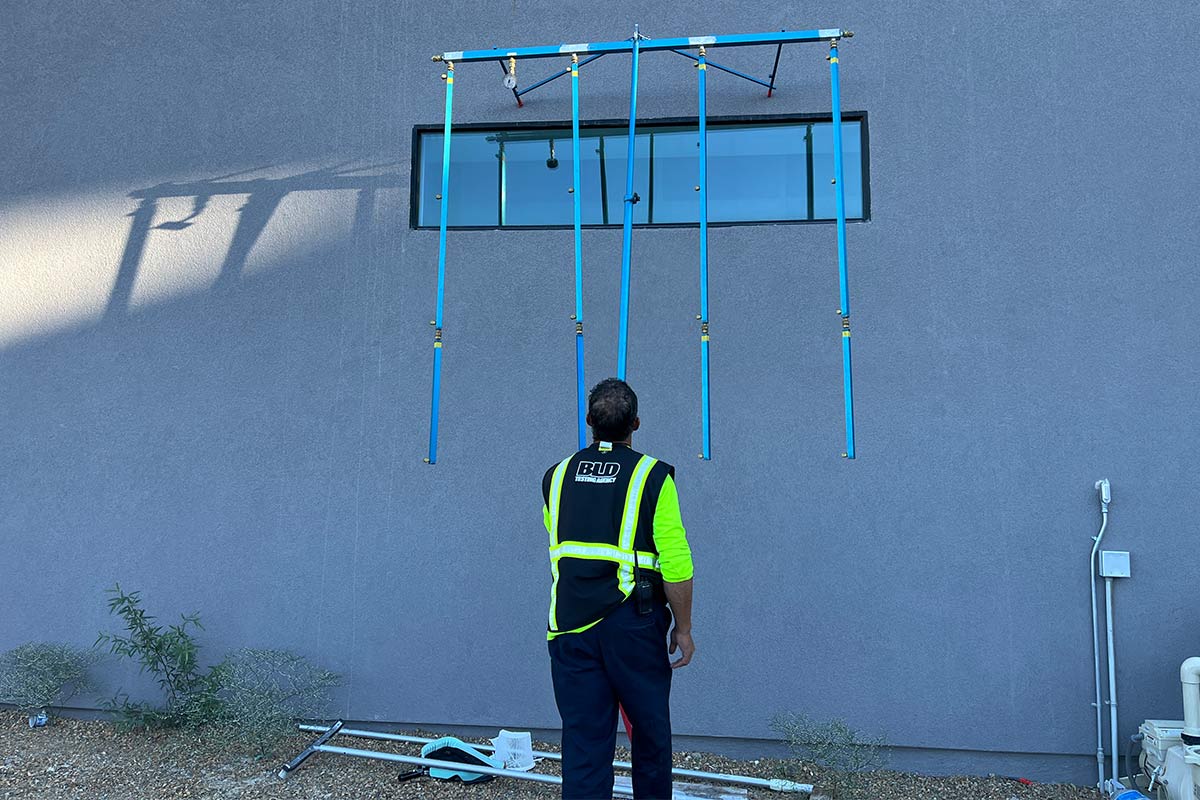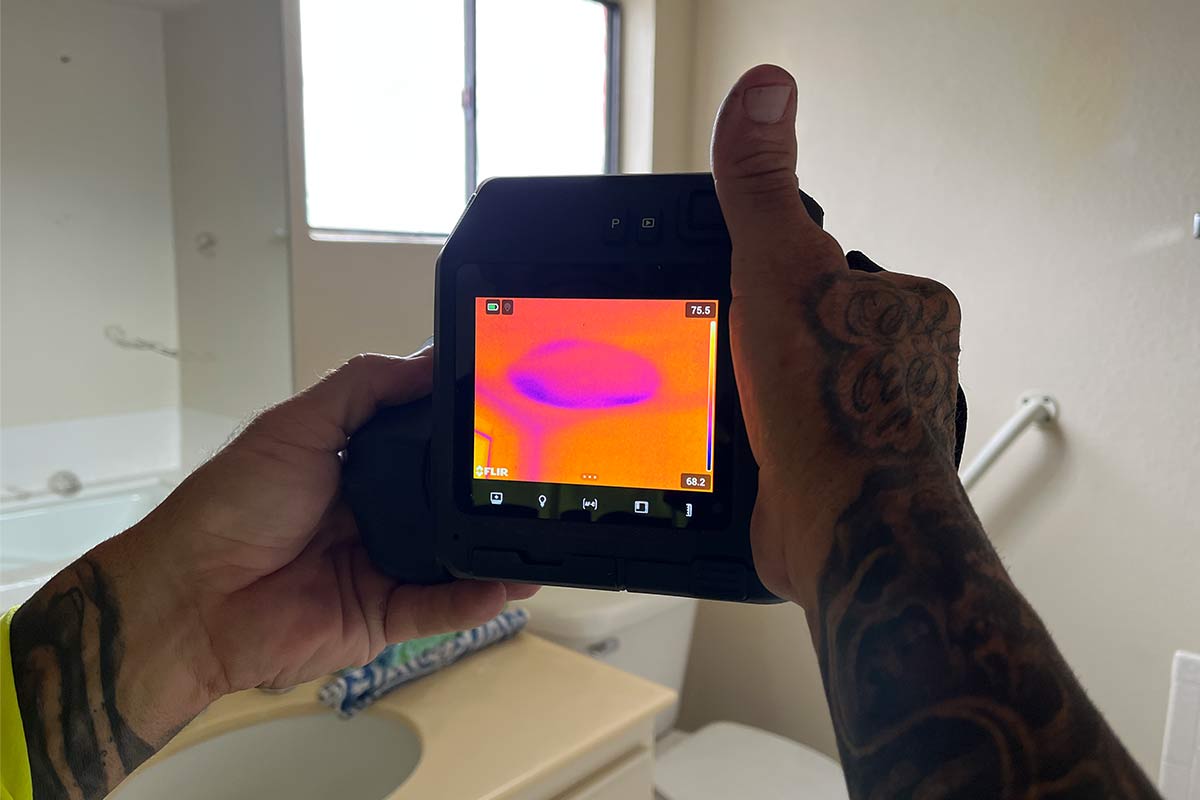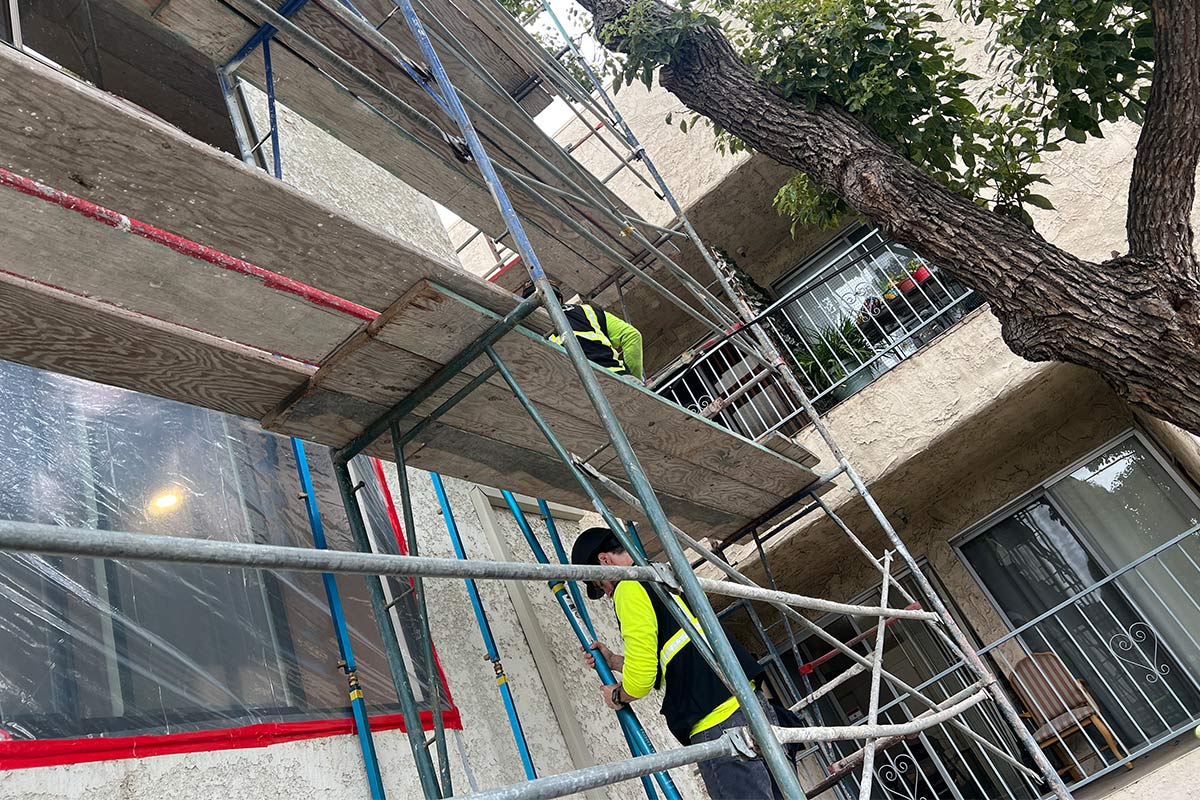Building wall Water intrusion leak Test in Phoenix Arizona
Water intrusion is one of the most crucial factors in maintaining the integrity of your Arizona building. No matter what city in Arizona, the climate is very extreme. Understanding how to properly protect your building from water damage can save you thousands in costly repairs. This is where water intrusion testing comes into play. Testing your building will provide a critical first line of defense for commercial and residential buildings alike.
With the understanding of the Arizona climate, especially in the Phoenix area and the weather patterns associated is so very important. Arizona is well known for its arid conditions and still experiences intense monsoons which leak to extremely heat downpours that can last hours. It’s this type of rain that ca stress a buildings envelope making it more susceptible to water infiltration.

Understanding Water Intrusion in Phoenix
By and large, when water infiltration usually occurs when water penetrates the envelope of the structure. The envelope can be the walls, a window, door and or even the roof. In time, this water intrusion can lead to significant damage including mold and structural issues. Monsoons in Phoenix Arizona are typical and bring heavy rains which leads to water intrusion.
So it’s not just the monsoons alone in Arizona that lead to water intrusion , the extreme heat can accelerate the deterioration of the buildings envelope. The buildings envelope is the only protection a structure has against water infiltration. Water leaking into a building can be subtle and go undetected for months and even years. What you as a home owner or building owner must understand is that the detection of such water intrusion can be extremely difficult and takes specialized equipment such as a spray wand or a spray rack used in a very specialized way.
As a home owner or building owner in Phoenix, here are a couple tips that will help with attempting to diagnose a potential leak in your building.
- After rain , look for discoloration or deformation of the walls or ceilings of your structure
- Stay vigilante to the smell of any indication of mustiness
- Look on the floor for puddles or other obvious indications that water has made it way into your building or structure
Early detection of water infiltration can be extremely helpful in reducing the overall cost of repairs and even structural damage.

Why Conduct a Water Leak Test?
Conducting a water leak test is important for bringing to light any vulnerabilities in the buildings envelope. These vulnerabilities may include the following;
- Missing stucco or siding
- Damaged or deteriorated windows or doors
- Damaged roofing materials
- Incorrect drainage around the structure
Types of Water Intrusion Tests are performed in Phoenix Arizona
There are several methods to test for water intrusion, each with its unique applications and benefits. Choosing the right test depends on the specific vulnerabilities of your building and the type of protection you seek to ensure.
But what test do you have to perform? Well, the ASTM and AAMA have devised a number of tests which can be administered by a professional water testing agency in order to locate water infiltration where it originates. Some of these tests include;
Just to name a few. Each of these tests when administered correctly here in Arizona, yeild amazing results. The results can therefore be used to conduct the necessary repairs in your home of office building and keep it leak free. Moreover, water leak tests can serve as an important part of a building’s overall maintenance strategy. By performing regular inspections of your building you can reduce the potential for future water infiltration.

ASTM E1105 Water Test in Phoenix
The ASTM E1105 water test is a widely recognized standard for evaluating the water penetration resistance of windows, curtain walls, and doors. This test uses a controlled flow of water applied to the exterior of the building while maintaining a specific air pressure difference across the assembly. The goal is to simulate conditions that might cause water to penetrate the assembly and identify any leaks. This test is particularly effective for assessing new constructions or recent renovations to ensure they meet the required standards for water resistance.
The ASTM E1105 test is especially valuable for identifying potential weak points in the building’s design or construction that might not be evident in visual inspections. By replicating real-world weather conditions, this test can reveal hidden vulnerabilities that could lead to water intrusion, allowing property owners to address them before they result in damage. This makes the ASTM E1105 an essential tool in both new construction projects and ongoing building maintenance.

AAMA 501.2 Test in Phoenix AZ
Another standard test is the AAMA 501.2 test, which is specifically designed for exterior walls. This test involves spraying water onto the building’s surface to simulate wind-driven rain. It is particularly useful for identifying potential leaks in curtain walls and storefronts. The AAMA 501.2 test is beneficial for buildings exposed to harsh weather conditions, ensuring that exterior walls can withstand the elements without compromising the building’s integrity.
The AAMA 501.2 test is not only effective for identifying current issues but also for validating the effectiveness of repairs or upgrades to the building’s façade. By simulating extreme weather conditions, this test can confirm whether recent improvements have enhanced the building’s resistance to water intrusion, providing property owners with confidence in their investment.
Water intrusion Inspection Here in Phoenix AZ
In addition to the specific ASTM and AAMA testing protocols , a comprehensive water damage and moisture intrusion inspection of the building soon after rain is extremely advantageous. The inspection will involve a thorough examination of the structures exterior walls as well as the interior walls and ceilings for indication of moisture. An infrared camera is an amazingly useful tool. It has the ability to look for water without having to perform destructive testing. Or the removal of wall coverings.
A water damage inspection gives a complete picture of a building’s overall condition. Instead of focusing only on areas that are directly tested, it looks at hidden spaces—such as for example, wall cavities, subfloors, and other concealed areas—where water damage can easily go unnoticed. This thorough approach helps identify all possible sources of moisture intrusion, ensuring that underlying problems are caught early and the building remains structurally safe and sound.
The Process of Conducting a Water Intrusion Leak Test
Conducting a water intrusion leak test involves several steps to ensure accurate and reliable results. Each step is critical to the success of the test and requires careful planning and execution.
Preparation for a water infiltration test
Prior to executing a water infiltration tests, we just first prepare the site to be tested. The very first thing to do is review any construction documents, inspect the buildings exterior and identify areas that are most susceptible to water intrusion. Furthermore, preparing the equipment for testing and briefing the team members as to what the testing protocol will be is crucial. Everyone needs to work as one.
If the building is occupied such as a condominium complex the occupants must be made aware of the testing protocol as well. This will ensure the smooth application of the test with no interruptions. Clear communication is critical with anyone and everyone affected by the testing.

Performing the Test
During the test, whichever test is administered; the water is applied to the building’s exterior under controlled conditions to simulate wind-driven rain. For the ASTM E1105 test, this means maintaining a specific air pressure differential within an interior wall mounted chamber all the while, spraying water onto the test area.
For the AAMA 501.2 test for example, water is applied using a calibrated wand or spray nozzle. Now this test is very aggressive in my opinion. Precise execution of these procedures is critical to ensure accurate results that truly reflect the building’s resilience to water penetration.
Performing the test also involves careful monitoring on the inside of the structure in order to detect any signs of water intrusion as it enters. The interior team is the most important roll because we must be vigilant in observing the building’s response to the simulated conditions. Noting any leaks or weaknesses that emerge immediately. This requires a keen eye and a thorough understanding of the testing standard being administered as well as the building’s construction and potential vulnerabilities, ensuring that all issues are identified and documented.

Analyzing Results
Once the test is complete, the results are analyzed to identify any points of water penetration. This involves checking for visible leaks, water stains, or damp areas inside the building. If leaks are detected, additional possible destructive testing or investigation may be required to determine the cause and appropriate corrective action. Analyzing the results also includes compiling a detailed report that outlines findings and recommendations for addressing any issues.
The analysis phase is crucial for developing an effective response plan. By understanding the specific causes of water intrusion, property owners can implement targeted solutions that address the root of the problem. This not only resolves current issues but also prevents future occurrences, ensuring the building remains protected against water damage.
Three Benefits of Water Intrusion Testing in Phoenix
Water intrusion testing offers numerous benefits for property owners, especially in a climate like Phoenix. By understanding and leveraging these benefits, building owners can enhance the longevity and value of their properties.
Preventative Maintenance
Identifying potential leaks before they become significant problems is key to preventative water intrusion testing. By addressing issues early, property owners can avoid expensive repairs and prolong the life of their building. Preventative maintenance not only saves money in the long run but also ensures that buildings remain safe and habitable for occupants.
Regular testing as part of a preventative maintenance strategy can also help in maintaining the building’s aesthetic appeal. By preventing water damage such as staining or mold, property owners can preserve the visual integrity of their buildings, enhancing curb appeal and tenant satisfaction.
Ensuring Structural Integrity
Water intrusion can compromise a building’s structural integrity, leading to safety hazards and costly repairs. Therefore regular testing helps ensure that the building’s structure remains sound and secure. Furthermore, by identifying and addressing weaknesses early, property owners can reinforce the building’s defenses against water intrusion, maintaining its stability and safety for occupants.
Ensuring structural integrity is not only about immediate safety concerns but also about long-term sustainability. A structurally sound building is more likely to withstand environmental stresses over time, reducing the risk of catastrophic failures and maintaining its value as an investment.
Protecting Health
Water intrusion can lead to mold growth, which poses health risks to occupants. Conducting regular water intrusion tests helps maintain a healthy indoor environment by preventing mold and mildew from taking hold. Protecting the health of building occupants is a critical responsibility for property owners, and water intrusion testing is a proactive measure to ensure a safe living or working space.
In addition to preventing mold, regular testing can also improve indoor air quality by preventing the conditions that lead to dampness and mustiness. This contributes to a more comfortable and healthy environment, enhancing the overall well-being of occupants and reducing the risk of health-related complaints or legal issues.
Choosing a Professional for Your Water Intrusion Test
Hiring a professional to conduct a water intrusion test is essential for obtaining accurate results and ensuring your property is protected. Here are some tips for selecting the right professional:
Experience and Expertise
Look for a company with a proven track record in water intrusion testing like Building leak detection Company. Their experience should include familiarity with various testing methods, such as the ASTM E1105 and AAMA 501.2 tests. A company with extensive experience is more likely to understand the unique challenges posed by different building types and environmental conditions, providing tailored solutions that meet your specific needs. In addition, a company who travels in multiple states is also useful.
Experienced professionals can also offer valuable insights and recommendations based on their past work, helping property owners make informed decisions about maintenance and repairs. Their expertise ensures that testing is conducted efficiently and effectively, delivering results that can be relied upon for planning and decision-making.
Reputation and Reviews
Research the company’s reputation by reading reviews and testimonials from previous clients. A company with positive feedback and a strong reputation is more likely to deliver reliable results. Customer reviews can provide insights into the company’s professionalism, reliability, and customer service, helping you choose a provider that aligns with your expectations.
In addition to online reviews, consider seeking recommendations from industry peers or professional associations. Personal referrals can offer additional assurance of a company’s capabilities and trustworthiness, ensuring that you choose a provider that will deliver high-quality service and support.
Certifications and Qualifications
Ensure that the professionals conducting the test have the necessary certifications and qualifications. Certified professionals demonstrate a commitment to industry standards and best practices, providing confidence in their ability to conduct thorough and accurate tests. Having these certifications also reflect a professional’s dedication to ongoing education and training, ensuring that they remain up-to-date with the latest testing techniques and technologies. This commitment to excellence ensures that your building receives the highest level of protection against water intrusion.
Conclusion
Water intrusion is a serious concern for property owners, especially in climates like Phoenix, Arizona. By conducting regular water intrusion leak tests, you can protect your building from potential water damage, ensuring its longevity and safety for years to come. Whether through ASTM E1105, ASTM 2128, and AAMA 501.2 tests, or comprehensive inspections, taking proactive steps can save you time, money, and stress in the long run.
In summary, water intrusion testing is an essential part of building maintenance. By understanding the various testing methods and their benefits, you can make informed decisions to protect your property and keep it in top condition. Consider reaching out to a qualified professional to schedule a water intrusion test today and safeguard your investment against the damaging effects of water. Proactive testing is not just a necessity but a wise investment in the future of your property, ensuring it remains a safe, healthy, and valuable asset for years to come.
